My E-Bikes / Specs
Here are reviews of my 4 e-bikes (plus a few others I've looked at).
My current e-bikes are:
VanMoof X3: great all-around/starter city bike. One size fits all, automatic shifting, "boost" button for quick starts. $83/mo includes theft replacement, insurance, maintenance.
Brompton Electric: most compact fold, easy to bring into buildings/stores, great all-around city bike, one size fits all.
Tern Vekton Q9: folding cargo bike, one size fits all.
Specialized Creo: electric road-bike; light and fast, long range.
Each is useful in different contexts, and together they cost less than half the $40k average new car in the US (see below for starter packs from $2k or $83/mo, 1/20th to 1/10th the avg new car price).
I'll probably end up with 1 or 2 more. In particular, I want the ability to take people+cargo on rides that would otherwise require an SUV (which might still be worse in various ways, and would definitely cost much more), so I'm eyeing a RadWagon.
Specs
A rough overview of the specs on my e-bikes (and a few other models I've looked at):
Bike
Weight (lbs)
(add-ons during weighing)
Battery Wh
Range (max boost, no extra battery)
Range (min boost, extra battery
Price (base)
Gear / add-ons
Price (total)
One size fits all?
Top speed
50.2
front+rear racks, handlebar bags
504 (+378=882)
30mi
70-90mi?
$2300
Theft/maintenance plan ($690), extra battery ($350), front basket ($90), rear rack ($70), panniers ($190), basic bags/mounts ($250)
$4000
✅
20mph (US class 1)
40.6
party lights, bags, battery
300 (+300=600)
25mi
60-80mi?
$3800
Extra battery ($690), city bag ($250), basic bags/mounts ($250), rack ($185), panniers ($170)
$5400
✅
20mph (US class 1)
35.2
handlebar bags, flat kit
320 (+160=480)
30mi
130mi
$7000
Extra battery ($450) + cable ($35), "Y" charger cable ($65), bottle cages (2x$25), basic bags/mounts ($250), "egress" pocket ($70), flat kit (hand pump, tubes+levers; $60)
$8000
❌
28mph (US class 3)
56.6
battery, panniers, basic gear
400 (+500=900)
30mi
100mi
$3200
Panniers (2x$100), basic bags/mounts ($150); 400Wh/500Wh extra batteries cost $629 ($777) but I've not bought one yet
$3600
✅
20mph (US class 1)
41 (estimate, relative to Creo)
320 (+160=480)
30mi
130mi
$3750
Similar to Creo, ≈$1000
$4750
❌
28mph (US class 3)
78
basket, bag, front rack
672 (+672=1344)
25mi
100mi
$1900
Extra battery ($550), bags/seats could total $300-$600?
✅
(20mph) (US class 1)
My E-bikes
Excellent all-around / starter e-bike
Many great/unique features:
"Boost" button: extra pedal assist, makes starting+stopping easy+fast
Automatic shifting: very convenient in urban settings with frequent starts/stops
"Peace of Mind" plan: theft protection/replacement, insurance, maintenance
Internal lock + alarm: nice first line of defense; coupled with a "Peace of Mind" plan, makes it easier to take+leave places
You may want to be within range of a VanMoof shop (I recommend booking a test ride if you are!)
The battery is not removable, so you need to be able to keep the bike somewhere where you also charge it
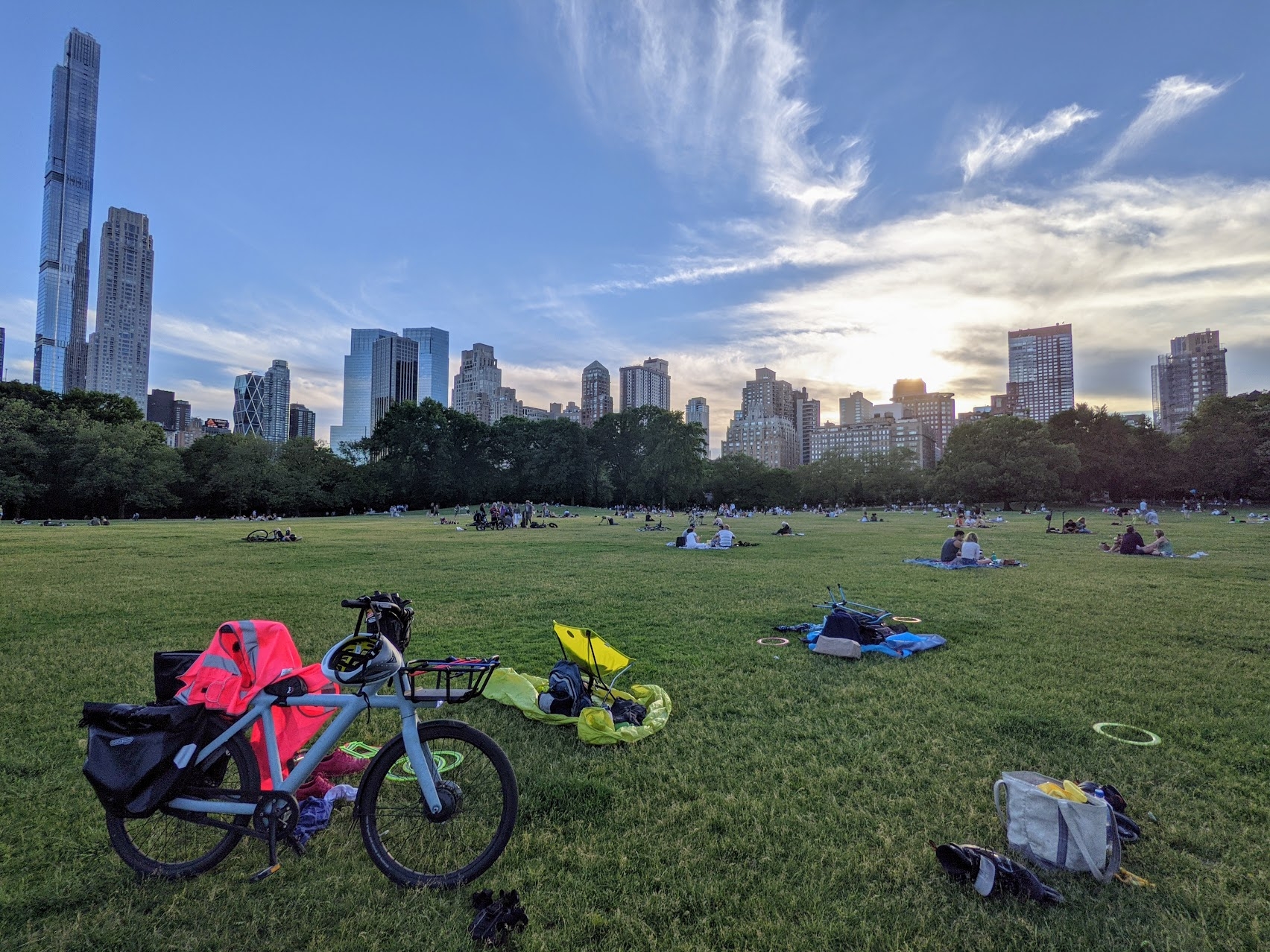
"Boost button"
When you press or hold this button on the handlebar, the pedal assist is amplified for a few seconds. It's great for accelerating from a stop, or holding a line in traffic.
It's one of my favorite features on all my ebikes; I've noticed I am an extra curteous rider on my VanMoof because stopping and starting again is no sweat, thanks to the boost button.
Automatic Shifting
VanMoofs automatically shift gears for you, based on your speed, which makes for a simpler/carefree riding experience. I really appreciate it when city riding; on my other bikes I shift down and then up again, sometimes by multiple gears (usually 6 on my Creo!), every time I stop and start again. Less experienced riders can also be intimidated by gear-shifting, so it's a nice accessibility feature as well.
It took a bit of getting used to; I first tried it in a very hilly place, and it was especially confusing. Some tips:
Use the "boost" button liberally on uphills, and when starting from a stop.
The gears shift based on your speed (not cadence, or torque).
Sometimes you'll have started slowing down on an uphill, pressing hard on the pedals and making little progress turning them, and it won't have down-shifted yet, which can be frustrating.
Eventually, you will slow down enough, and it will shift down
Also, reiterating: I recommend just laying on the boost button when climbing.
I spent some time in the app micro-managing the speeds at which it would shift into each gear. After a bunch of thrashing, I think I ended up back at almost exactly the factory defaults 😂 (having also learned the glory of the turbo button).
"Peace of Mind" plan: theft protection, insurance, maintenance
VanMoof's "Peace of Mind" plan gives you 3 years of theft protection, insurance, and maintenance for $690. It's not the cheapest, but knowing that I have backup if anything goes wrong is very reassuring, and it's the kind of offering I expect other brands to move toward as well.
If your bike gets stolen, VanMoof's "bike hunters" will try to recover it in 2wks, or replace it for you.
Internal Locking
VanMoofs have a lock inside the bike. You engage it by pushing a button on the frame, and disengage it from the app on your phone.
It doesn't stop someone from picking the bike up and throwing it in the back of a truck, but the bike does make an alarm sound if moved while locked, and VanMoofs have a few other forms of DRM (including a tracking chip and "bike hunters" team) that hopefully make them less attractive to thieves.
Reliability / Shop Proximity
A common refrain on r/vanmoof is that you should be prepared to take it to the shop for tune-ups or troubleshooting.
I've had to go in once because we transferred ownership of the bike between VanMoof accounts, and it ended up stuck in "EU mode" (with a top speed of 20kph, instead of the US's 20mph). It was easy enough to fix in the shop. I've popped in a few times when I was in the neighborhood to have them try to make my brakes less squeaky (with mixed results), or just to top up my charge a bit.
Shipping
I've observed them to quote a 2-3mo timeframe for shipping, only to have the bike show up in a couple weeks!
Range
I get ≈30mi to a charge, using the "boost button" liberally.
I'll receive a "PowerBank" extra battery in the next few weeks which I expect will increase my range to ≈50-60mi.
A full recharge takes a few hours.
Reviews
r/vanmoof: lots of more grassroots reviews/discussion here
Gallery
I stayed in a friend's apt for 2wks via VanMoof:
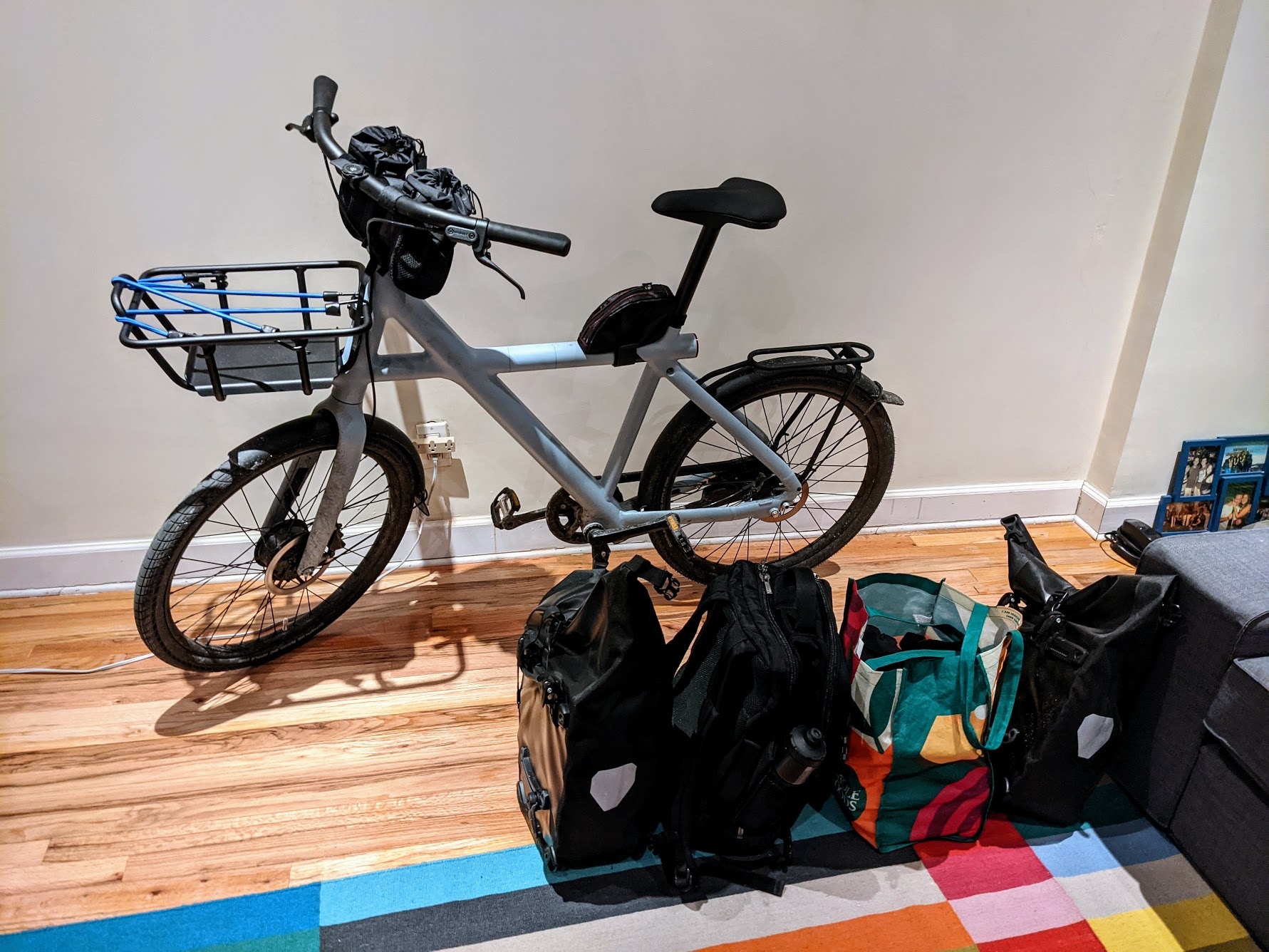
It worked well through the winter:
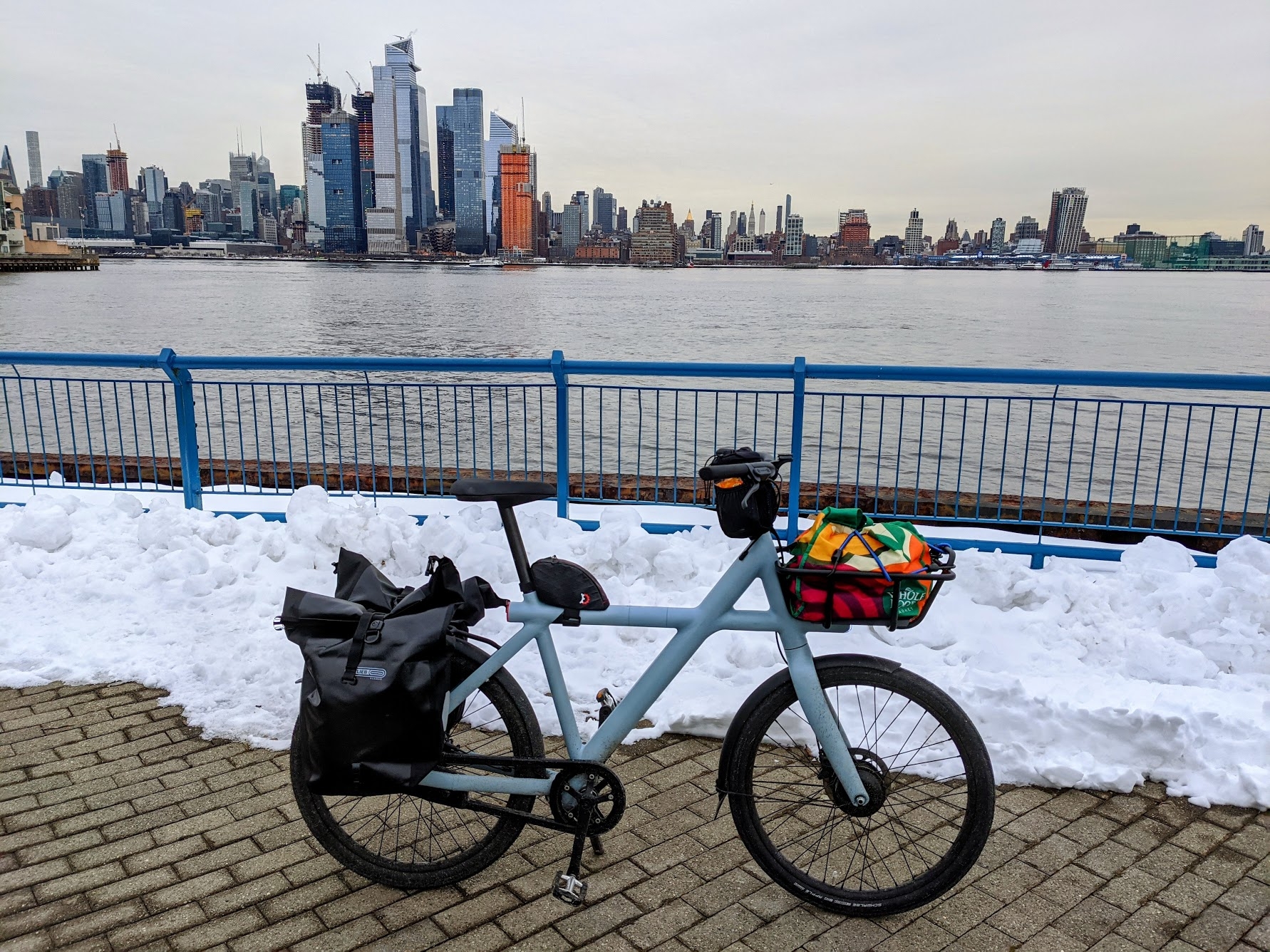
I take it to Central Park pretty regularly, with picnic/Aerobie gear:
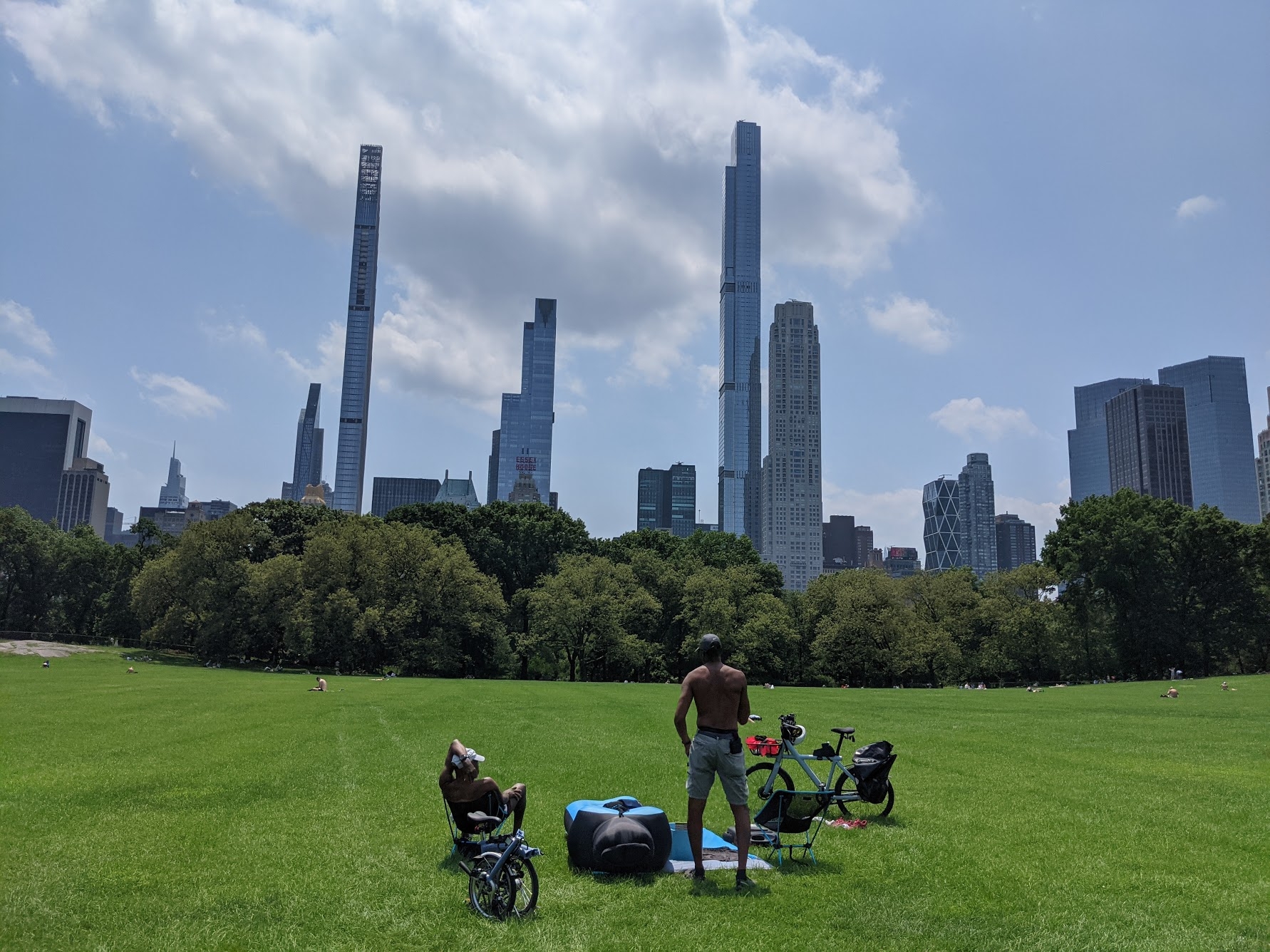
I also occasionally do grocery runs with it:
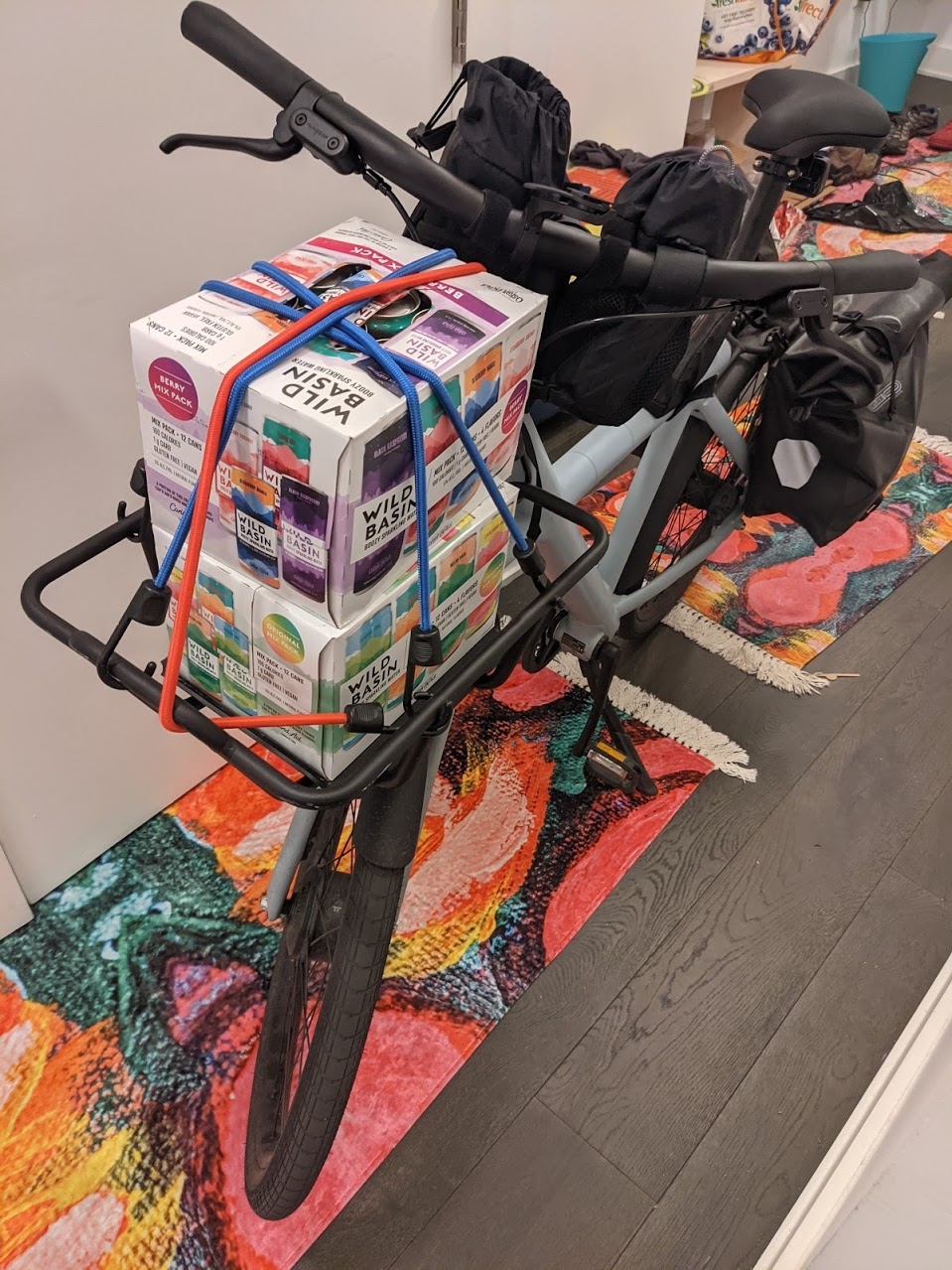
Bromptons are a classic/famous British folding bike, and they did a decent job engineering a motor and battery onto the front. I bought mine from Redbeard Bikes in Brooklyn (delightful store run by a couple who have been very helpful through my process).

Pros
Most compact fold of all bikes (electric or not!); relatively portable (fits in an airplane overhead bin!, though flying with ebike batteries either requires special permission or is impossible).
Surprisingly nice ride / feels like a normal bike (despite looking a bit flimsy/silly due to small 16" wheels).
Decent extra battery story for increased range; currently my 2nd highest range ebike (after the Creo) as a result.
Great mix of fun/whimsy with real transportation / portability / overall utility.
Cons
Expensive ($3800) for relatively small amount of bicycle/machine. They're well-made, so I felt it was worth it (once I'd covered other ebike use cases), but the price point is simply too high for most people I talk to.
Supply chain has been especially backed up since COVID.
Still a bit heavy to lug around (32lbs just the bike, 38 w/ battery, 40 with a rack).
Gallery
Brompton Electric, folded, next to a much larger/heavier throttle e-bike:
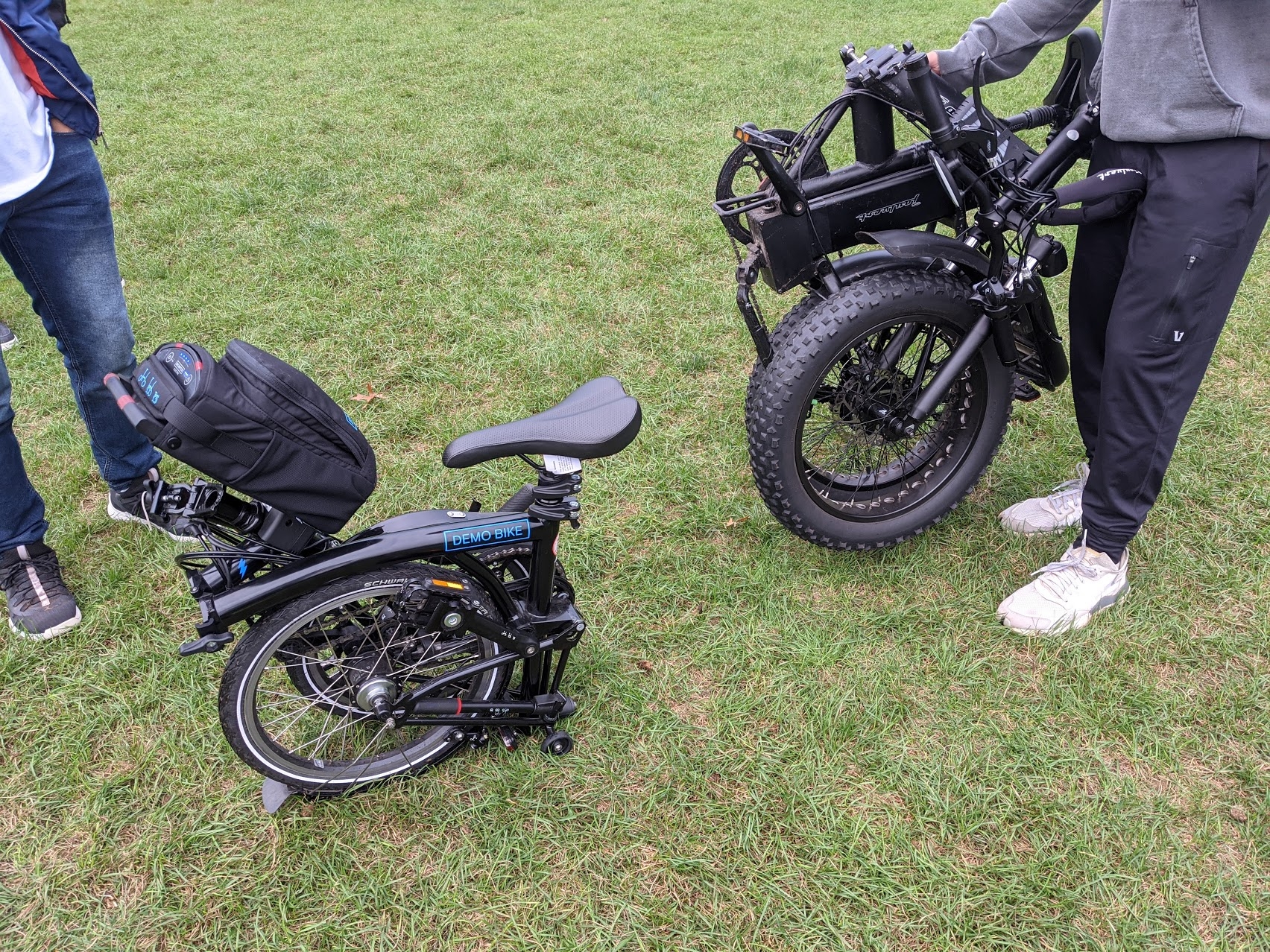

Folded into "shopping cart" mode inside a CVS:
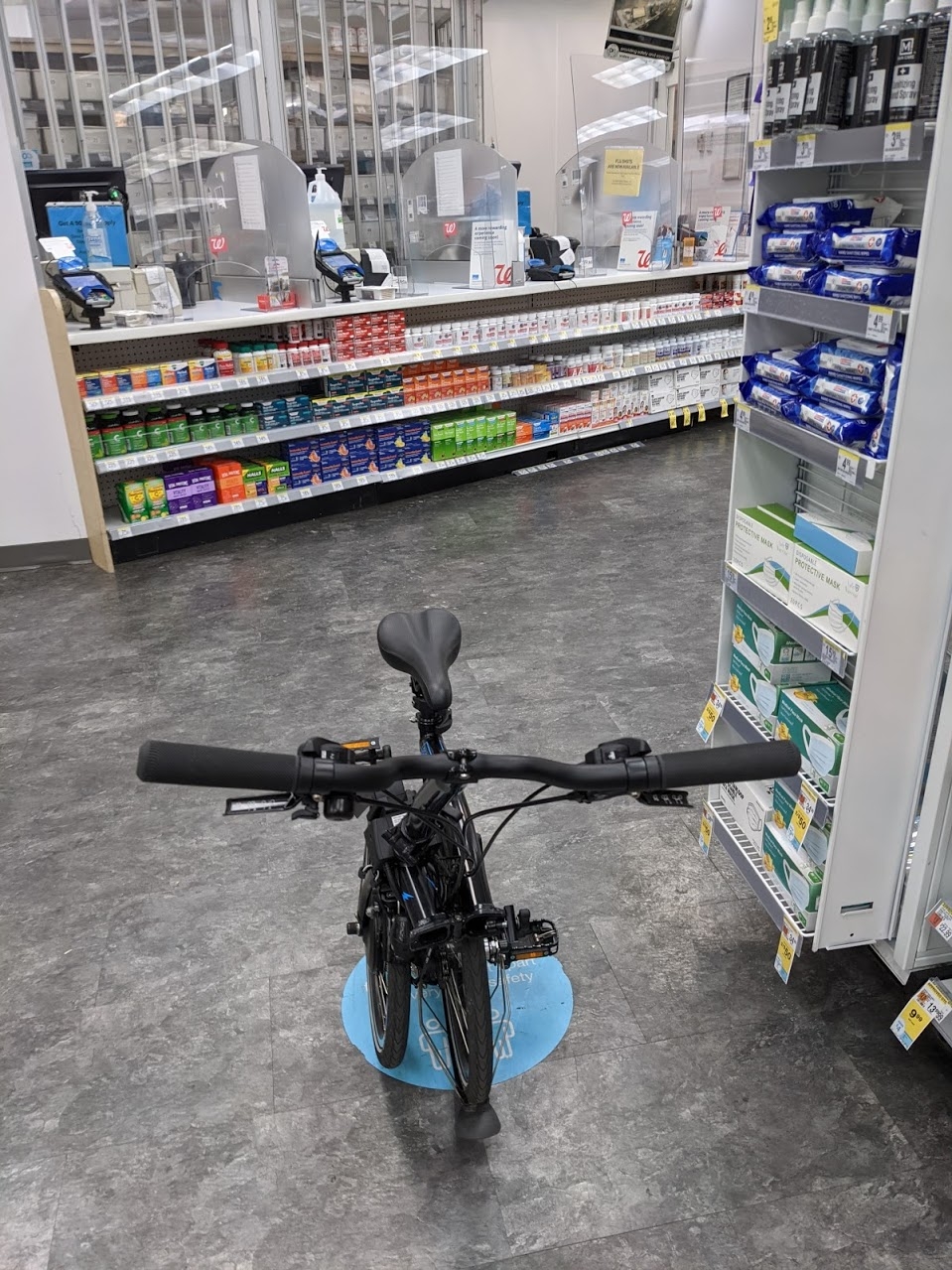
This was my first ebike, from Bfold, a delightful bike store in the East Village (David was really helpful at talking me through the market when I was starting from zero).
I also test rode a Vektron at Propel in Brooklyn, who had a very slick appointment-booking flow and beautiful inventory of Reise & Muller bikes. Their YouTube channel is also an excellent source of ebike info; here's their review of the Vektron.
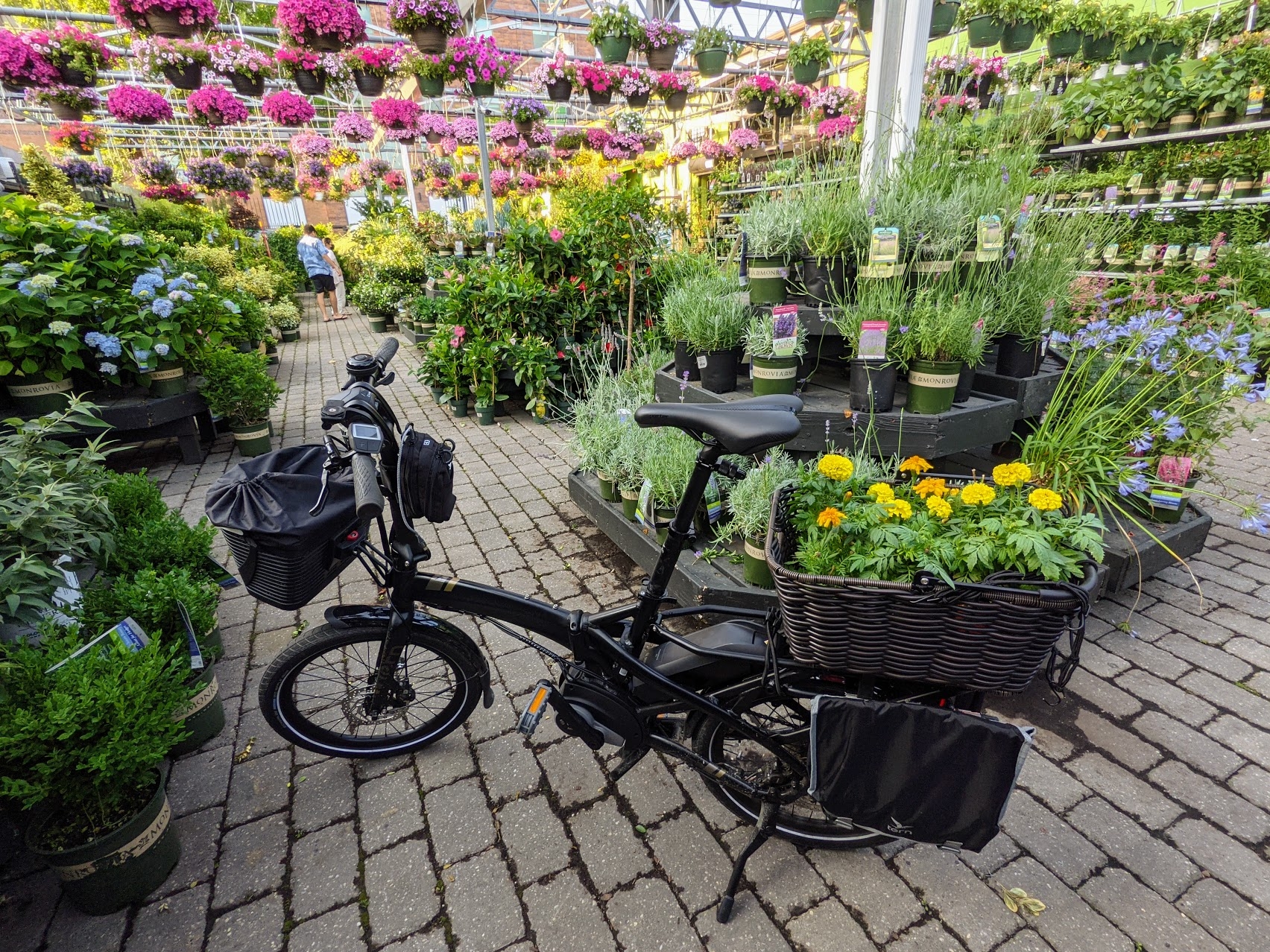
Pros
High-quality + rugged; Bosch motor system is premium.
Folding, cargo, and electric are hard to find in one bike.
The Vektron is the only model I know that does a good job at all 3.
See "Grocery Runs".
Nice folded+rolling mode (demo video).
One size fits most (4'9"–6'5"); good telescoping seat post, adjustable handlebar/stem system.
Cons
Expensive ($3200): it's obviously a heavy-duty machine, so it's clearer what you are paying for, but that's still sticker-shock-inducing for most people
Heavy (49lbs): again, this is understandable given its sturdy build and cargo-hauling emphasis, but you don't want to carry it up stairs
Still large when folded: it folds in half (as opposed to the Brompton's thirds), folded footprint is more "corner of room" than "under desk".
A minor annoyance is that the battery recharge socket is blocked by the frame, so you basically have to take the battery off of the frame to charge it. It's pretty easy to do though and not a big deal, to me.
Gallery
My Tern and Brompton, folded in my office:
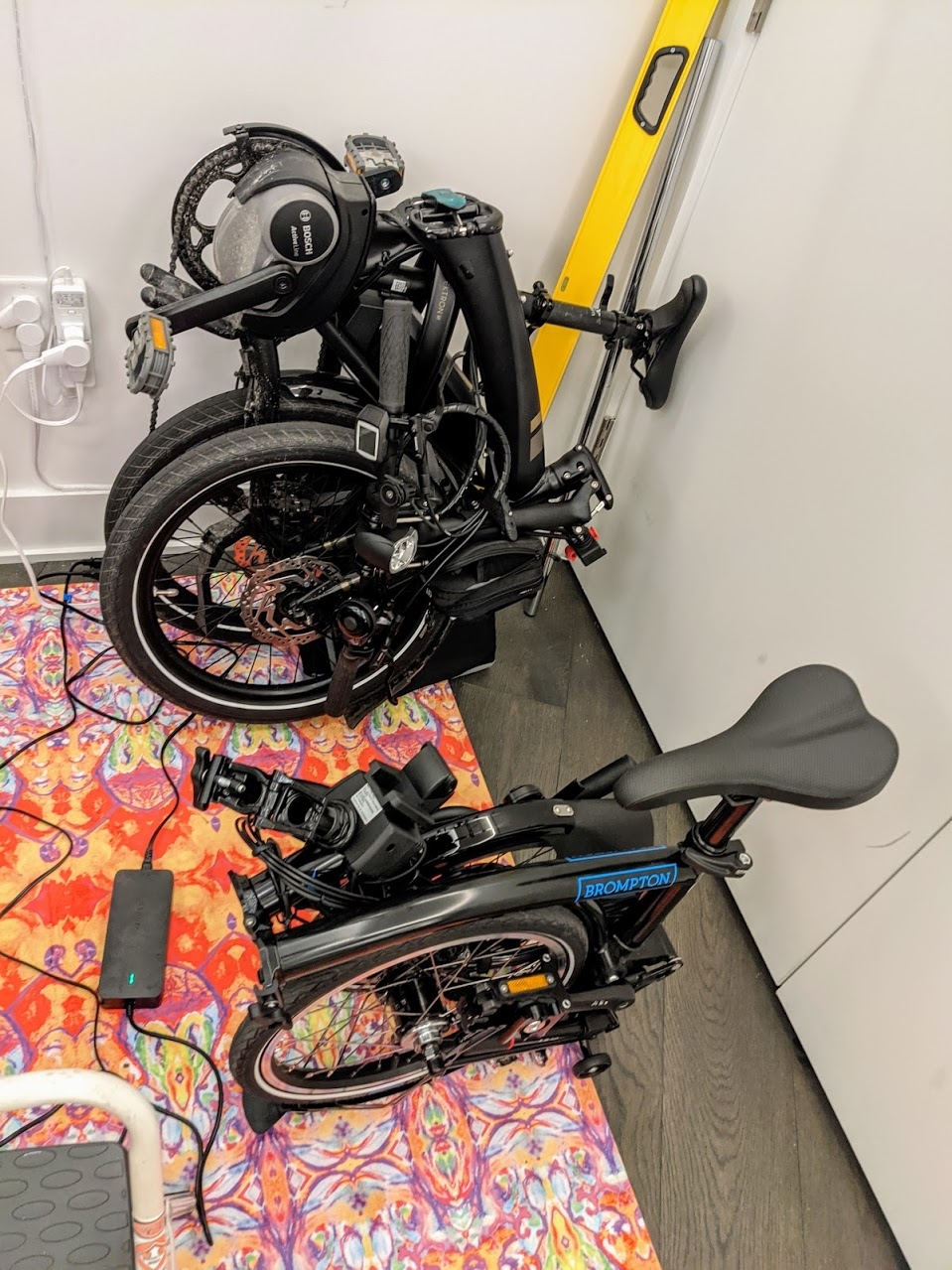
Carrying groceries:
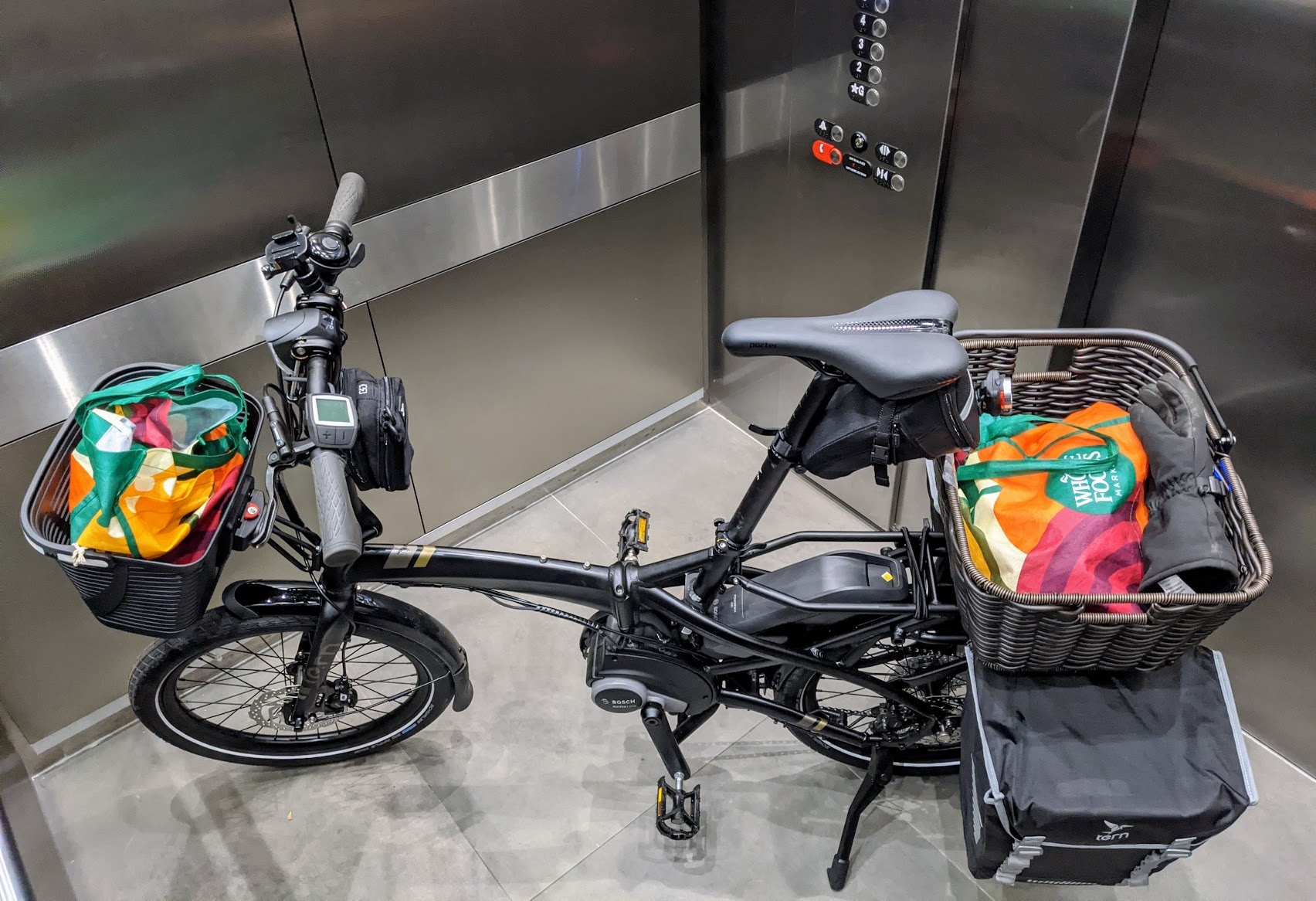
The Creo is a high-end, carbon-frame road-bike with a slick integrated motor+battery. Specialized seems to be one of the first brands to have executed on this really well, and the result is a transportation machine the likes of which has never existed before. It's really incredible: light, fast, fun to ride, smooth pedal assist, very efficient / long range.

The "never existed before" claim can be applied to many ebikes, since there are many companies exploring a huge design space, and leveraging cutting-edge battery and bike material technologies, but the Creo is remarkable for having many of the best attributes of ebikes as well as of performance road-bikes. It starts at 28lbs (including battery+motor), has the most range (40-130mi, depending on boost level and extra battery use), and provides a mobility superpower that very few people have experienced.
Specialzed "Turbo" E-Bikes
Specialized is one of the most famous bike brands, and "Turbo" is their ebike line. Their branding and marketing pages confused me at first, but I eventually decoded the marketing-speak:
There are 4 types of Specialized "Turbo" ebikes:
Creo: road bike
Levo: mountain bike
Vado: hybrid (b/t road and mountain) bike
Como: city bike / cruiser
Within each line, a few variants may appear:
EQ ("EQuipped"): comes with fenders and a rack
Carbon: most Creo and Levo models have carbon frames, but their entry levels are a slightly heavier aluminum alloy
Expert: slightly nicer and lighter than the entry-level carbon frames (e.g. carbon wheels, better shifter)
S-Works: this is Specialized most prestigious brand (ebike or otherwise); generally 2x the price for benefits that seem marginal to me (but I've never ridden one, and I'm a casual enough cyclist that I'd rather have 2 Creos so a friend could ride one with me than one S-Works 😄)
Finally, the links above go to marketing sites for each ebike line, but from there you can click through to the actual shop pages, and some decent model-comparison pages.
Motor / Battery / Range
tl;dr:
40mi (60mi w/ extra battery that fits in water bottle holder, plugs into bike during ride) on boost 2 (of 3)
90mi (135mi w/ extra battery) on boost 1 of 3
smaller battery and less powerful motor are nontheless very efficient
road-bike setup means it's easy and efficient to provide power yourself; bike just gives you a nice boost
At first blush some Specialized ebike specs seemed underwhelming. For example, the Creo has a 320Wh battery and 240W motor (the lowest of all my ebikes).
However, some combination of factors results in my Creo getting by far the most range of all my ebikes:
lower power levels generally seem to correspond to more total range; a twice-as-high boost level will exhaust a battery more than twice as quickly
lower power output from the bike means it is effectively tricking you into supplying more power, over a given distance
building on the above, the road-bike posture means it is easy and comfortable to actually work on the Creo; my other ebikes are more upright, and it's hard to help the bike much even if you want to (or get a real workout)
the carbon frame (and smaller battery+motor) make the Creo 10-25lbs lighter than my other ebikes, so a given Wh battery goes further
I usually ride on boost level 2 (of 3), and get 40mi (or 60 with the range extender, which is the slickest extra-battery story on any of my ebikes). The motor is super smooth, it feels like you are riding a really nice roadbike but with an incredible tailwind giving you an extra 3-5mph. It also provides assist up to 28mph (whereas my other bikes top out at 20mph).
For longer rides, or rides with leg-bikers, I can drop to boost level 1, where it's effectively just compensating for the extra weight of the motor+battery (maybe a bit more), and I get 90mi (or 135 with the range extender, presumably; I haven't tested that yet!).
Pros
It's a dream to ride: fast, fun, efficient, long range, and feels like a really nice road-bike.
You can work as much as you want on it; there are even professional cyclists starting to use it for training.
Lightweight for an ebike (28lbs):
More like 35lbs with the baggage I always keep on it (tubes/pump in handlebar roll bag, misc junk in handlebar "snack bags").
Not exactly "throw over your shoulder" light, but a big difference from other ebikes that are 2x that weight or more (electric citibikes are 75lbs!).
Smaller frame battery combined with "range extender" extra battery means it's easy to shed a few lbs of battery weight if you know you won't need it (as opposed to other ebikes that have a large/heavier battery as the default option)
Cons
Cost ($7k): obviously this is way out of bounds for most people. I was one of those people, but once I found myself a couple ebikes in, having done a lot of research + demos, gotten very excited about the space (and exploring where the limits were and what was possible), and made peace with a significant ebike budget (embracing ebikes as a substitute for a car), I was drawn to it.
No integrated lights, difficult to add bags / carrying capacity, difficult/uncommon to add fenders: it is meant to be an elite racing bike, and added accessories/weight is pooh-pooh'd by bike shops and experts. Nevertheless, I wanted a lightweight+fast ebike for transportation, so I have made some "bikepacking" configurations work.
Gallery
Loaded up for a bike-train-bike-boat-bike trip home from my in-laws' in Westchester:
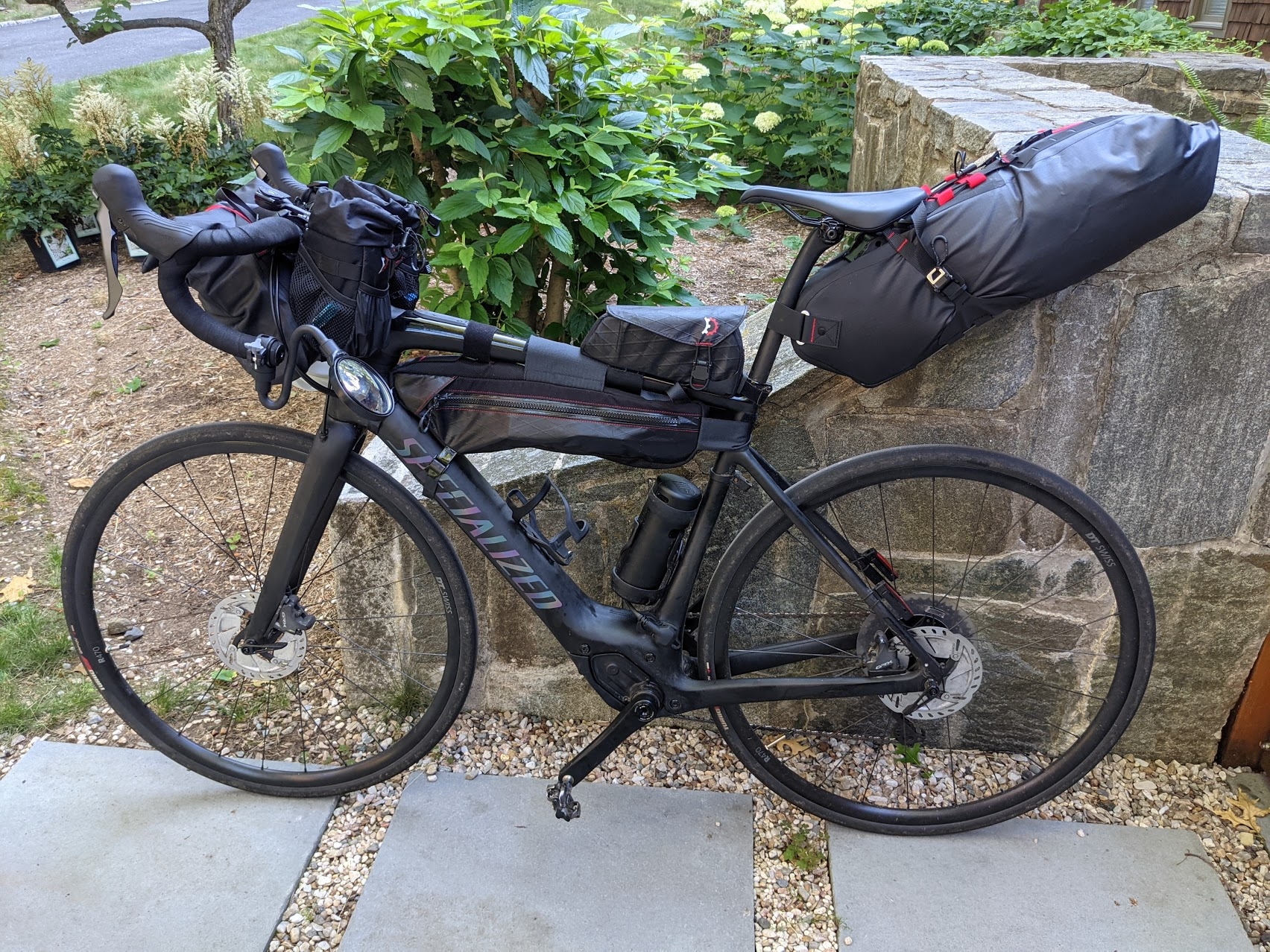
Same trip, at the ferry at 39th St on the west side of Manhattan:
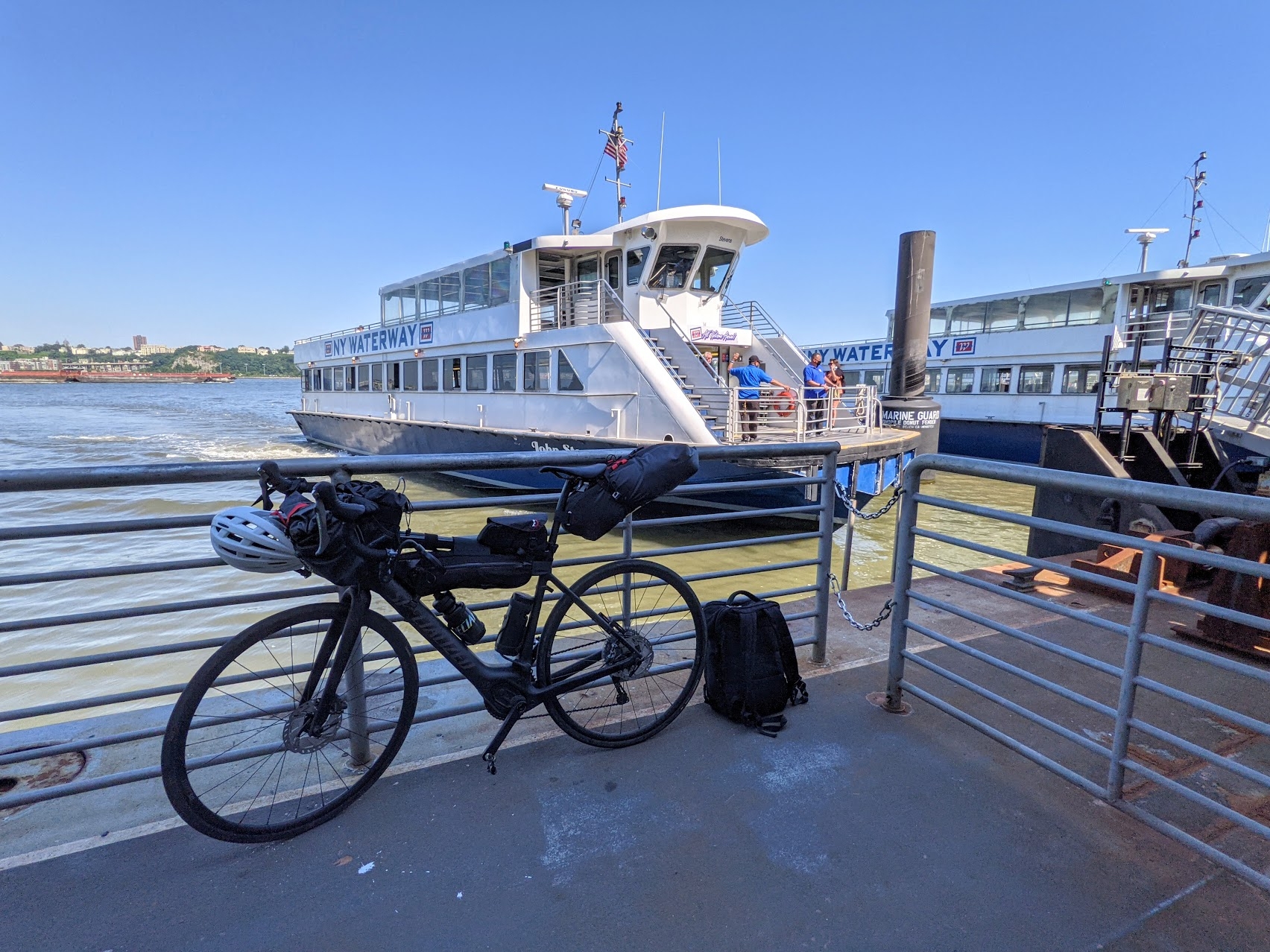
≈2.5hrs door-to-door (similar to taking a car to Metro North then subway from Grand Central, and comparable to a 90-120mins drive), with less than an hour biking:

My longest ride to date was a 93mi day on the "Harbor Ring" ride (around New York harbor, except for the 2mi Verrazzano bridge between Brooklyn and Staten Island, which has 13 lanes for cars and biking/walking is prohibited):
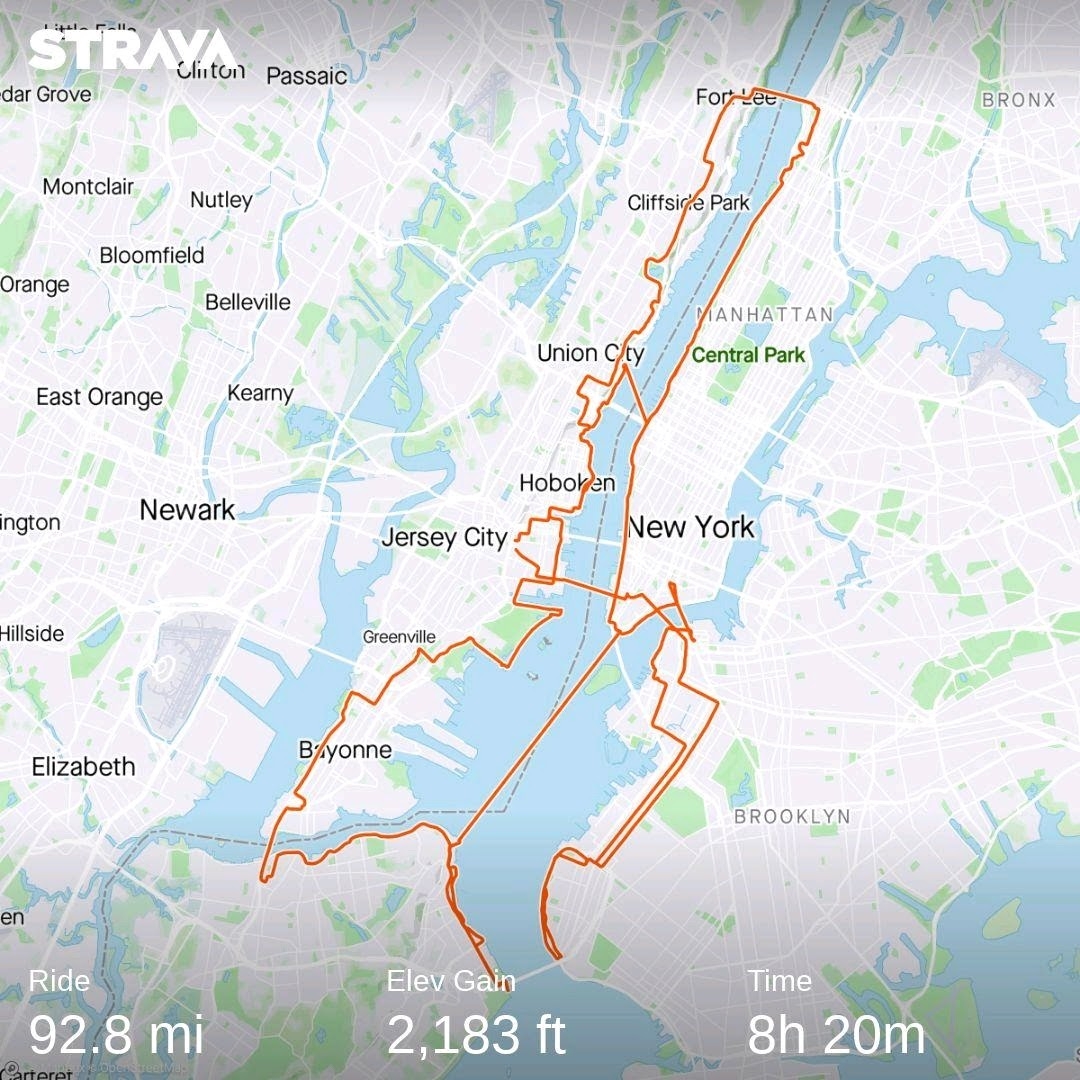
I was leading a group of leg-bikes, and alternated between boost levels 1, 2, and 0 (just riding it as a regular road-bike with some extra weight, which was also totally fine; I was generally still slowing down to wait for folks).
Other Notable E-bikes
Some other models I've looked at or helped people buy:
This is the "hybrid" (straight handlebars, but fast like a roadbike) version of my "Creo" electric roadbike (part of the Specialized "Turbo" ebike line discussed above). It has the same motor/battery system that I love from the Creo, and is also just an incredible machine. It has essentially all the speed/range/quality of the Creo, but you can put a rack and panniers on it and haul stuff / use it around a city a bit more easily.
My sister-in-law has a Vado 4.0 SL EQ, and my mother-in-law has a "step-through" version. I've been thinking about getting a Vado 5.0 SL EQ (newer model, has a couple nice features over the 4.0 (like the "Future Shock" handlebar suspension).
This is a true cargo e-bike (as opposed to my Vektron Q9, which has less capacity and power, as a foldability tradeoff) for just $1900. RadPower is aggressively targeting a mainstream price point, seemingly mimicking Tern designs but with less premium components and a more mass-market focus.
This is a leading contender for my 5th e-bike, since I still have occasional cargo/hauling needs beyond what I can accomplish with my Q9, and it is so aggressively priced.
Cool sporty/design-y folding ebikes. They seemed a bit expensive and lacking in hauling capacity for what I needed when I demo'd them, but could be good commuter bikes.
A friend recently got one; it seems like a good commuter bike: cheap ($1400), powerful, has a throttle.
They had a huge crowdfund campaign, and the specs seem like the best of several worlds (folding, lightweight carbon, powerful motor, large battery; an e-folder that's 10lbs lighter than the Brompton, and more powerful).
I was able to test-ride one at Greenpath in Brooklyn; I felt like I might miss having multiple gears, and the carbon frame had some flex to it that I found a bit disconcerting. I've heard that low-quality carbon frames can fail in catastrophic ways, so I ultimately decided to let the "carbon e-folder" space mature / dust-settle for a bit before looking at it again. I had recently narrowly missed clicking "buy" on United City Bikes' "The One", which was a similar crowdfunded low-cost carbon e-folder, only to have them liquidate the company the next day 😭!
Things are moving fast in ebike-land, and there's something to be said for going with reputable brands and stores you can go to for service!
Last updated
Was this helpful?